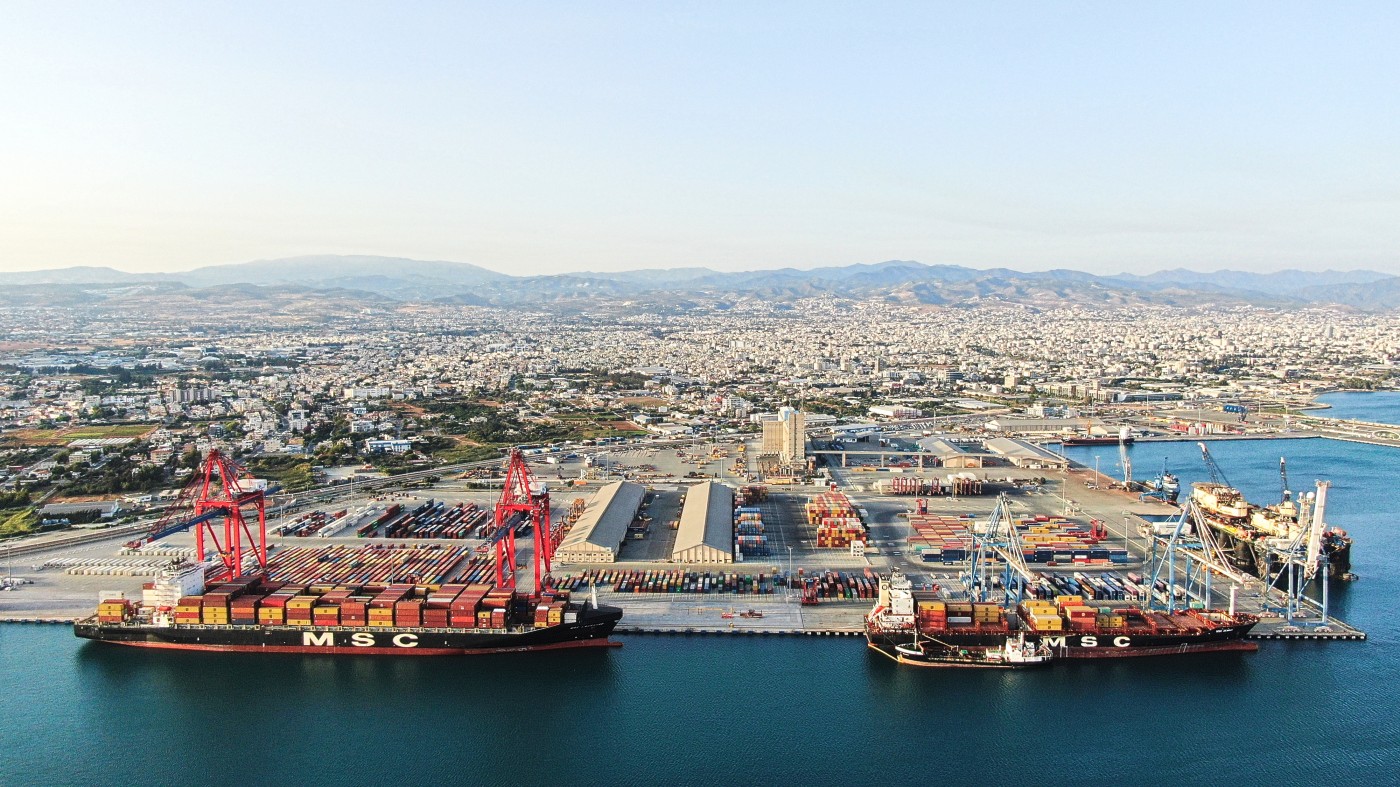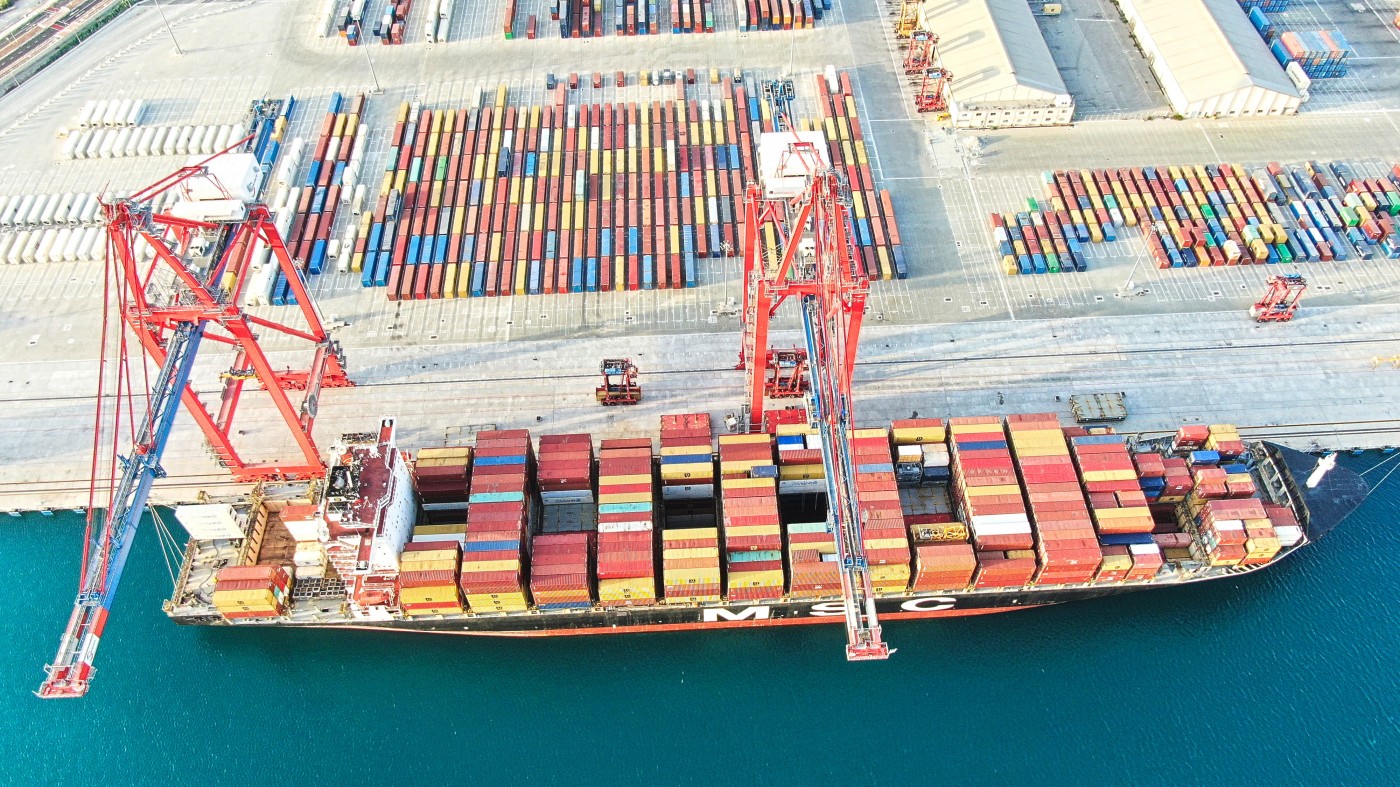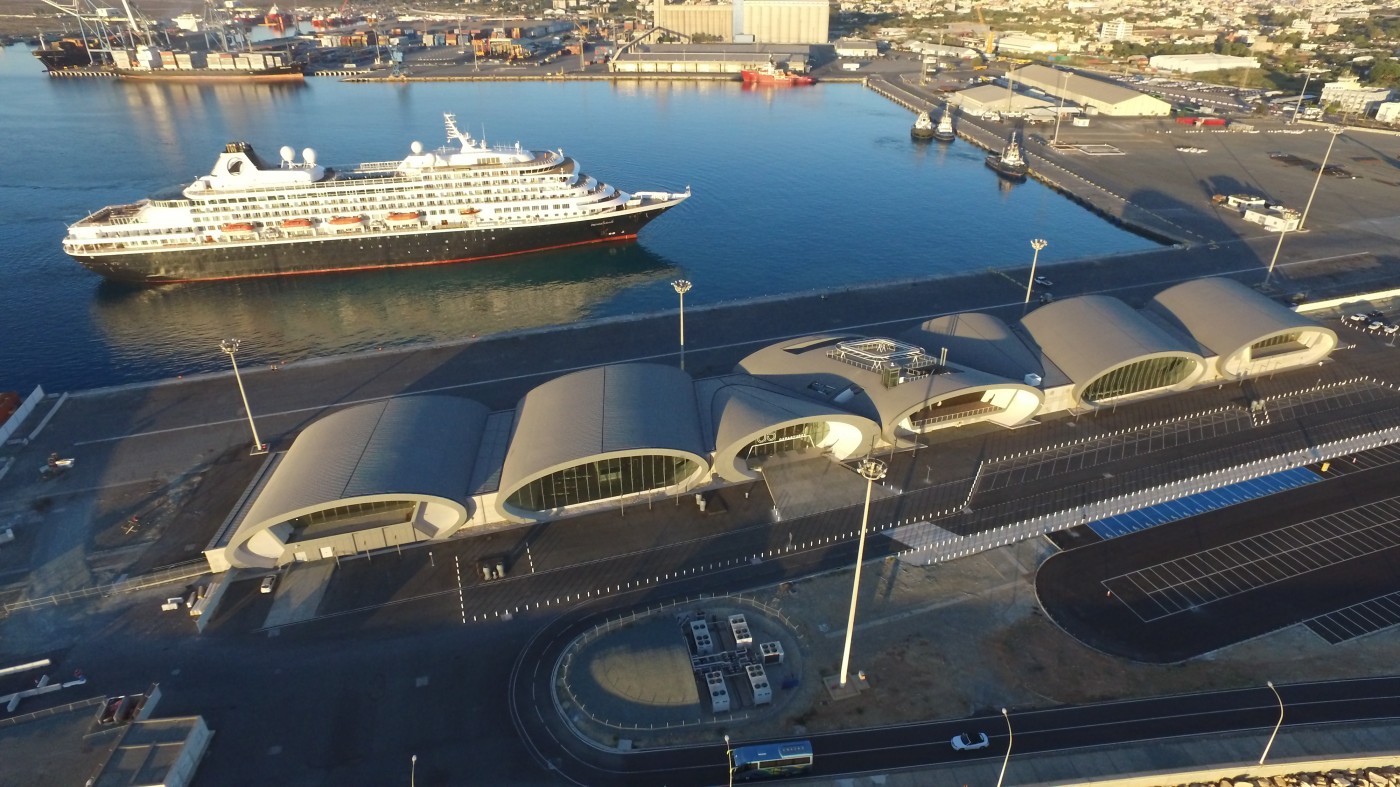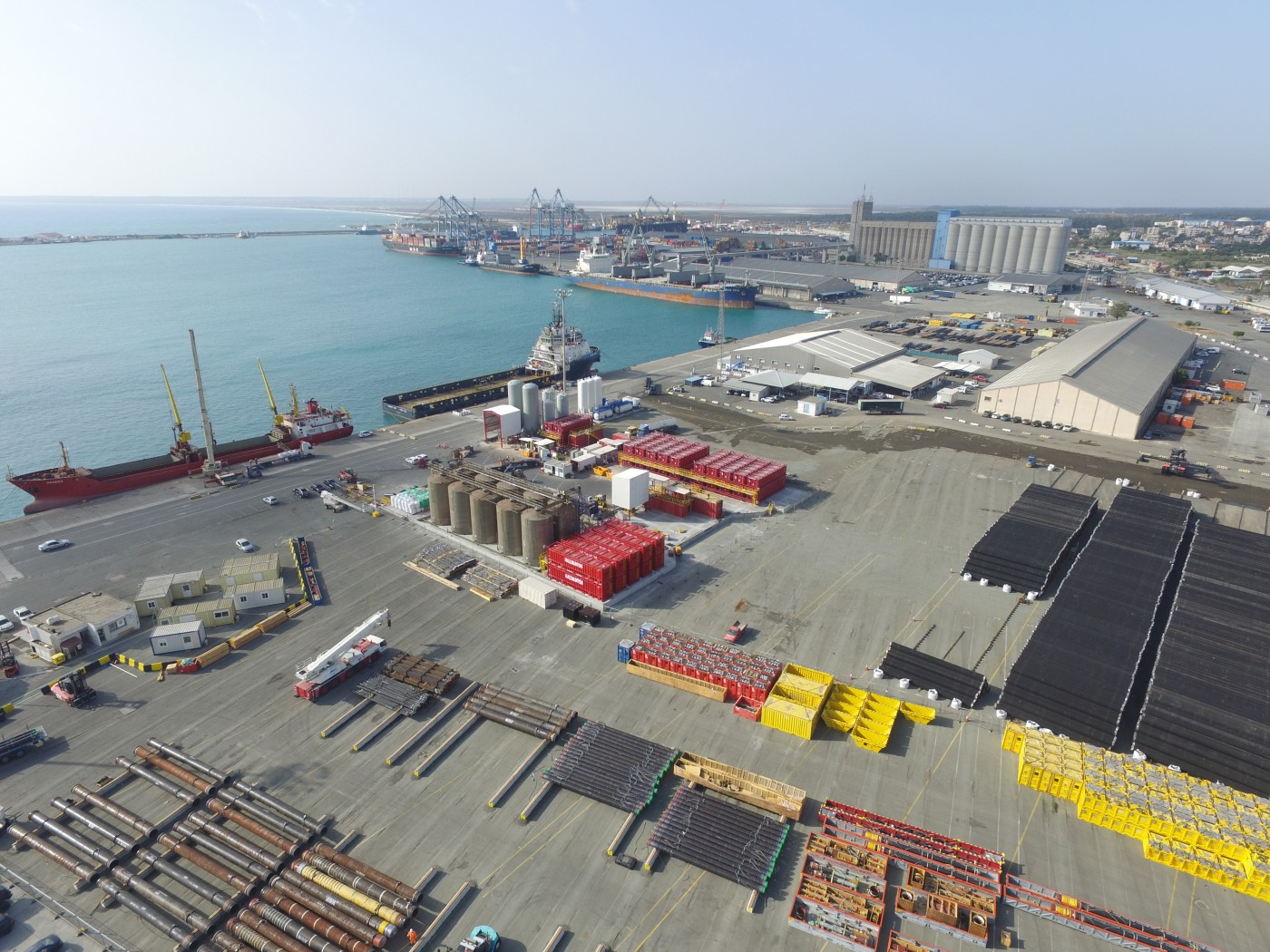29 November 2019
This month, we are interviewing Mr. Panayiotis Agathocleous, Port Manager of the Port of Limassol (Cyprus). In what follows, Mr. Agathocleous explains us about the main characteristics and challenges of his port, how he got into maritime transport, the importance of transshipment to the port, the impact of geopolitics on the port, and many more interesting subjects!

Can you briefly present the Port of Limassol? What are its main characteristics and challenges?
The continuous process of changing international transport management in the last thirty years from a segmented modal approach towards a much more integrated transport concept, tailored to better meet the pressing needs of customers, the globalisation of the economy, the massive political changes and the deep financial crisis at the early years of the current decade that affected the port sector as well as the establishment of more market-oriented governments, has allowed port privatisation to be more vigorously pursued and resulted in an increasing pressure on our ports to adapt their role and function to this more demanding operational environment. These trends entailed the rethinking of port development strategies as well as the introduction of the necessary reforms in the legislative and managerial environment within which Cyprus ports have to operate nowadays and in the years to come.
Considering the fact that Cyprus is a small island country which depends heavily on its ports for its trade, acknowledging this is of high priority, as well as the development, and further improvement of the port infrastructures and the establishment of an efficient seaborne transport system. The Cyprus Ports Authority, through the Ministry of Transport, Communications and Works, examined more closely the Authority’s managerial role as well as the improvement of its role in the regional port industry. Thus, one of the first actions taken, as part of the ports’ long term strategy, was to provide opportunities to the private sector to participate more actively in the provision of port services. This in turn attracts more capital investments within our ports and improves port efficiency, safety and security. At the same time our ports and port services are adapting in order to be able to meet the existing and future requirements and needs of the market, including the search and exploitation activities of natural gas that are taking place in the Eastern Mediterranean basin.
As a result of the above actions and since February 2017, all port services at Limassol port are being provided by the private sector and the 3 Concessionaires that have been given a concession agreement under tender competition.
The 3 Concessionaires that are now providing port services at Limassol port are:
- Eurogate Container Terminal Limassol, being responsible for the operation of the port’s container terminal;
- DP World Limassol, being responsible for the handling of General Cargo and Passengers;
- P&O Maritime Cyprus Ltd, being responsible for providing the Marine Services.
Through this commercialisation of the Limassol port services, Cyprus Ports Authority, from being the landlord and operator of the port, now has the role of landlord and regulator of the port services, acting at the same time as a collaborator and partner for the materialisation of the goals of the three Concessionaires and the port’s vision.
The commercialisation of Limassol port services is a project of strategic importance as it will not only improve the competitiveness of the port over the next decades, but also contribute to the further revival of the economy and increase of growth.
Nearly 3 years after the beginning of this ambitious project of the commercialization of the port services, I feel that this structural reform of the Limassol port and the transition to the new regime has shown positive results in financial as well as operational terms, with efficient and high quality services being offered to the port users and with safety, environmental and security standards at their highest levels. There are still lots of things that can be done to increase the ports productivity and efficiency, two important elements that can bring significant benefits to our country. To this end, we are working closely with the three Concessionaires, the Ministry of Transport and the port stakeholders.
With regard to the characteristics of the Limassol port, it is the main and largest commercial port of the island, serving both cargo and passengers. Its construction started back in 1971 and was concluded in 3 implementation phases in 1996, with some modifications on its infrastructure and superstructure taking place until today. The sea area of the port is around 1 sq. km while the land area is around 1,3 sq. km. The port infrastructure includes a total length of quays of 2.500m, closed and open storage areas, container stacking yards and reefer installations. The port superstructure includes 5 gantries cranes, 2 of which are new super post panamax cranes as well as mobile cranes and various types of cargo ground handling equipment. Regarding the provision of marine services, 3 tug boats and 2 pilot boats are available. The port basin depths vary from -11m to -16m. A new passenger terminal is now in operation, a landmark building of a total of 7.000 m², that covers all the requirements of relevant regulations regarding security and safety in handling passengers.
How did you get into maritime transport? How did your career path lead to this position?
Maritime transport and port industry are exciting and at the same time challenging fields for someone to work for, thus I consider myself lucky and at the same time excited to be part of these sectors. My academical background is related mainly to the business administration and management fields. I have university degrees in Business Administration, and an MBA and a Master in Port Management, all from British universities.
Before joining the Cyprus Ports Authority I was employed for nearly 5 years by one of the largest law firms on the island, with international presence in several countries, as Strategic and Business Consultant to the Head Partner and as Quality Manager. In 2001, I joined the Cyprus Ports Authority as an Administrative Officer at the headquarters of the Organisation in Nicosia. During my 18 years of experience in the Organisation, I was appointed in several senior positions in the Organisation’s Administrative Department. I took over the position of Limassol Port Manager in 2017, after having served as an Acting Port Manager for nearly 12 months. The period between the years of 2016 and 2017 was one of the most challenging periods in my career within the Cyprus Ports Authority, as I had to deal together with my colleagues with the transition period of the new operational regime, the provision of port services by the Authority until February 2017, when the new Port Operators took over, as well as problems that arose for a period of 3 months after the commercialisation of the port services.
 Photos by DP World Limassol and Eurogate Container Terminal Limassol at Limassol Port, all copyrights reserved
Photos by DP World Limassol and Eurogate Container Terminal Limassol at Limassol Port, all copyrights reserved
What is your vision for the Port of Limassol for the next decade to come?
My vision for Limassol port, which actually reflects the vision of both the Cyprus Ports Authority and the three Concessionaires, is to establish the Limassol port as the most modern, productive, competitive and safe port in the South-Eastern Mediterranean, to serve Cypriot trade, the development of Transshipment Trade and Cruises, and to act as a hub port serving the needs of the oil and gas industry in the region.
The Port of Limassol is an important transit port. How do you see the evolution of the transshipment market? What benefits can you bring to your clients?
In the 1980s, the Limassol port has been actively engaged in serving transshipment trade. It was considered as one of the main transhipment hubs in the East Mediterranean region and lots of shipping lines were performing their related activities through the Limassol and Larnaca ports. Unfortunately this advantage was lost mainly for two reasons. The first reason was the high overall cost for serving transit containers in comparison with other neighbouring ports, and the second reason was the Turkish embargo that was initially imposed against Cyprus ports and Cyprus flag vessels calling at Turkish ports. These restrictive measures that Turkey illegally applies since 1987 which were extended in 1997 to all ships, irrespective of flag, which have a connection with Cyprus, unfortunately brought a lot of negative impacts to the island’s shipping industry and to Cyprus ports. More specifically, shipping lines, mainly of EU interests, which were using Cyprus ports as their transshipment hub for the Eastern Mediterranean region were obliged to abandon Cyprus and use other neighbouring ports for such operations. Also, certain shipping lines which have been serving the Cyprus trade for many years were compelled to change their schedules accordingly. These changes were a direct consequence of the Turkish measures rather than the result of economic considerations. Additionally, the competitiveness of Cyprus ports and their transit operations has been considerably influenced over the past few years by the Turkish embargo.
Several efforts on a political level and within the EU and other European forums and associations have been made over the years to lift these restrictive measures. However, despite the promises, nothing has happened mainly due to the continuous denial from the Turkish side.
Taking this opportunity, I would like to emphasise the need for a common action within the European and International Forums to exercise the necessary pressure against Turkey towards lifting the measures. Through these restrictive measures Turkey is knowingly opposing the development of all the European port policies, measures that constitute serious obstacles and I would say distortions in the direction of free trade within the EU.
Nevertheless, Cyprus Ports Authority has never ceased its efforts to re-establish the Limassol port as one of the most important transshipment hubs in the region. These efforts have now intensified with the support of the three Concessionaires that took over the operations at Limassol port. Thankfully and due to the continuous and practical efforts given by DP World Limassol and Eurogate Container Terminal Limassol, we are now seeing positive results in serving again transshipment trade at Limassol port.
DP World Limassol has already started handling transshipment cargo linked to the energy sector, including cargo that will be used for the exploitation of the gas fields within the Exclusive Economic Zones of Cyprus and of neighbouring countries in the Middle East. The transformation of the Limassol port into a transshipment hub for providing landside services to this sector and for the supply of energy companies in the Eastern Mediterranean region is of high priority and one of the immediate tasks of the company. Important investments were made in terms of providing the necessary infrastructure and equipment to serve these needs and a plan to further develop this aspect is already in place, which the company will follow with the support from the Government.
Eurogate Container Terminal Limassol, through an ongoing investment in equipment and technology and the implementation of modern management models, aims to increase turnover at Limassol port and attract additional companies. Their main priority is to attract transshipment trade to the terminal and ultimately develop Cyprus into a transshipment hub in the region, based on Eurogate Group’s vast and successful experience in serving transshipment trade. One of their initial investment was the purchase and installation at its Limassol terminal of two Super Port-Panamax Gantry Cranes, currently the biggest cranes in Eastern Europe and which can serve the world’s biggest vessels with an outreach of 23 containers. Once this sector is activated, Eurogate will make further investments in its equipment by installing another two Super Port-Panamax Gantry Cranes and hiring additional staff in order to accommodate the future needs of this market.
 Photos by DP World Limassol and Eurogate Container Terminal Limassol at Limassol Port, all copyrights reserved
Photos by DP World Limassol and Eurogate Container Terminal Limassol at Limassol Port, all copyrights reserved
The Port of Limassol is located on the Orient/East-Med Corridor of the Trans- European Transport Network (TEN-T). How has this been of benefit to the port? Has the port received EU co-funding from the Connecting Europe Facility for any projects?
At Cyprus Ports Authority we have always supported the recognition of the importance of co-financing measures under the 'Motorways of the Sea' to primarily improve accessibility between the peripheral regions and islands with the markets of the central regions. Cyprus, as an island Member State of the European Union located in the periphery and acting as the southeastern border of the European Union, deserves as much financial support as possible from EU co-funded projects mainly to improve its ports infrastructure and services.
The Limassol port has been benefitting greatly over the years of being located on the Orient/East-Med Corridor of the Trans-European Transport Network (TEN-T), especially through EU co-funded projects either from the Cohesion Fund or from the Connecting Europe Facility, through multinational actions. The latest project which received funding on a national basis was the preparation of a study regarding the expansion of the Limassol port Terminal 2, the Vasiliko Terminal, an expansion that will lead to the new industrial port in Vasilikos and which will operate as a service centre for the oil and gas industry and generally obnoxious cargoes that cannot be served in the other ports of the island.
Another significant project that received co-funding from EU Funds was the Elaboration of the East Mediterranean Motorways of the Sea Master Plan with the aim of creating “Motorways of the Sea in Southeastern Europe”, connecting the Adriatic Sea to the Ionian Sea and the Eastern Mediterranean, including Cyprus. Another project with significant importance that received co-funding was the dredging of the sea basin of Limassol port, in particular the dredging of the port’s approach channel and turning cycle to -17 metres and the western port sea area to -16 metres in order to accommodate the new generation of container ships. Recently we had the co-financing of the project of expanding the Limassol port’s western quay wall by 500m, a quay that is used for the berthing of the large container vessels.
In its latest position on TEN-T policy, ESPO stresses the need to strengthen the importance of maritime links, to put them on an equal footing with the TEN-T land links. Can you explain the importance of maritime links for an island such as Cyprus?
Maritime transport has always been the dominant mode of transport for serving European trade, both within the EU and with its trading partners across the world. In our immediate region, the East Mediterranean, maritime transport is simply the only alternative because of the geopolitical situation. The existence of an efficient maritime transport network in our region, as a vehicle of economic growth and prosperity, is of paramount importance.
In the case of Cyprus, an island economy with almost 90% of its trade being performed through its ports, maritime links are of key importance. Being a peripheral, small and insular Member State of the EU, Cyprus depends entirely on its ports for its trade, making the development and improvement of port infrastructures and the establishment of an efficient transport system high on the agenda of the Cyprus government. Relevant support is therefore expected and needed from the EU.
The extension and upgrading of our port infrastructure constitutes a significant factor for enhancing access capability to EU markets. The main objective of the strategy for a comprehensive development of port infrastructure is the upgrading of the competitiveness and effectiveness of our ports so that they are able to respond to the modern needs for the movement of goods and passengers. Their role as important nodes in serving international trade is also upgraded in this way. I believe that emphasis should be placed on supporting maritime transport of passengers, especially for peripheral/insular Member States, as an alternative to air travel in general but more specifically as an emergency service to maintain connectivity among Member States during incidents of air transport crises, natural disasters or terrorist activities. Also, the development of the Motorways of the Sea should be further supported through a higher funding rate. Cyprus’ close proximity to the busy trade routes linking Europe with the Middle and Far East can contribute substantially to the extension of the Motorways of the Sea in order to connect the European Union with the neighbouring countries in the Eastern Mediterranean and with the Far East markets.
Being close to the Suez Canal, Cyprus has a strategic position in the East Mediterranean sea. How does the Port of Limassol benefit from this position? Do energy commodities play an important role in the port?
Cyprus commercially benefits from its position at the crossroad of three continents (Europe, Asia and Africa). Over the years, this strategic position has benefited the Limassol port, especially in serving transit trade mainly in the 1980s and early 1990s before the introduction of the Turkish embargo.
Today, this amazing beneficial geostrategic position is the main tool guiding the strategic planning of the Cyprus Ports Authority and of the 3 Concessionaires in developing and further enhancing the Limassol port and its port services. As I mentioned earlier, our partners have recognised this and are already investing in terms of equipment and human resources in order to be able to receive all related benefits from this position with the ultimate goal to transform Limassol Container Terminal to one of the most important regional transshipment centres.
On the other hand this geopolitical advantage that Cyprus enjoys undoubtedly brings potential synergies that could result in an increase of the port’s general cargo traffic and transform DP World’s Limassol Terminal to an important shore-based logistics support hub that efficiently serves the port needs of the hydrocarbon industry and of the large amount of energy commodities that lie in the East Mediterranean sea. In order to achieve this task, DP World Limassol has been engaging with key players of the energy industry in an attempt to attract immediate investment and business to the Limassol port and therefore to Cyprus. They have also been continuously investing in the port in order to develop their terminal infrastructure such as the shore logistics base which was completed last year and was already used for the drilling operations that recently took place within the EEZ of Cyprus and of other neighbouring countries.
 Photos by DP World Limassol and Eurogate Container Terminal Limassol at Limassol Port, all copyrights reserved
Photos by DP World Limassol and Eurogate Container Terminal Limassol at Limassol Port, all copyrights reserved
Limassol is a popular cruise destination. How is the cruise business evolving in your port? What are the main challenges?
Everyone agrees that the international cruise market is growing fast. The Mediterranean is the south border of Europe and one of the most prosperous regions in the world with a very low cruise-market penetration. So significant opportunities exist in the cruise business for ports in the Mediterranean and especially in the East Mediterranean. In this part of the world, the weather is more stable, allowing for a longer season of cruising. Moreover there is a larger cultural diversity and well-known land-based attractions.
At this point I would like to emphasise that although ports may compete in other fields, in the cruise industry they form a complementary chain of a potential network of commercial partners, as cruise operators need a necklace of safe, easily accessible ports to plan their itineraries. Unfortunately in the East Mediterranean region, with the political instability in the neighbouring cruise destinations of the Middle East, synergies and common strategies to attract cruises is a difficult task.
Despite the above, Cyprus has always been an important cruise centre in the Eastern Mediterranean and has been included in the itineraries of most international cruise ships in the region. This is still the case today and with the direct involvement of DP World Limassol in providing all port services of handling passengers at Limassol port, the prospects of enhancing further the cruise industry in Cyprus are higher than ever before.
Limassol is a destination that offers excellent and various opportunities both for year-round excursions and for those who prefer a visit to the vibrant city of Limassol located just a breath away from port. The New Cruise Terminal in Limassol port inaugurated in 2018 represents a huge improvement in services and facilities, enhancing the experience of both cruise lines and passengers while significantly contributing to strengthening the sustainable development of tourism in Cyprus.
DP World Limassol has already launched a series of actions that promote the sustainable development of cruise activities locally and regionally through a specific promotional strategy that will target local and international travel agents and that form an overall strategic common goal for the East Med of extensive marketing and branding of the cruise product, of creating direct links with neighbouring countries and of targeting new tourist markets from the Far East.
All of the above-mentioned actions are without doubt important steps for the Limassol port to develop further its cruise business, which at the end of the day will serve as a catalyst for a positive change for us here in Cyprus and consequently will result in providing significant benefits to the country’s economy.
Cyprus is located near some important geopolitical hotspots. Has the current unstable situation in the Middle East led to any challenges or loss of traffic for the Port of Limassol?
Cyprus is positioned in the top right hand corner of the Mediterranean and at the South Eastern corner of Europe. The country is located between Europe, Asia and Africa, and by consequence rightly claims to be a stepping-stone to the three continents. Cyprus has played a leading role in the history of the Eastern Mediterranean and its history is one of the most ancient in the world with a civilisation dating back 10.000 years. Cyprus’s strategic location has been a major factor in shaping its history throughout the centuries.
The eastward expansion of the EU opened the door for a dynamic development and new opportunities for Cyprus and its ports. Enlargement has led to greater economies of scale and an improved trade and investment climate. The accession of Cyprus to the EU back in 2004 allowed Cyprus to act as an important bridge between the EU and the Middle East. It provided new opportunities for trade, investment and cooperation on important issues related to trade and the maritime. Moreover, our geographic advantage and excellent relations with our neighbours has made us a regional hub for business, attracting European companies to Cyprus in order to use the country as a launching point for operations in the Middle East, North Africa and beyond. This regional business hub has also extended to Limassol port, which acts as the first EU entrance or the last EU exit for shipping lines that are now using Limassol port as their home port for trading with the non-EU countries of the region. When there was not any political instability in the region, this consequently has led to an increase in the volumes of cargo traffic and ship calls being served at the port, with the Middle East countries as final destination.
However, the political changes and instability in the East Mediterranean region and specifically in the Middle East affects the maritime industry, in particular the calls of ships in ports of the countries that are under distress. A great negative impact of the regional political instability can be seen on cruise ships that sail in the region, like for instance cancellations of several itineraries that include not only countries that are currently facing political problems but also neighbouring countries, such as Cyprus and Greece.
In parallel with the above, extending the EU to the Mediterranean was not simply a balancing move for the previous enlargement to Central and Eastern Europe, it was also a necessity dictated by the policy options already decided upon and applied by the Union, aiming to consolidate peace and stability by extending the policy frontiers far beyond those physical borders of the Union. The Lebanon crisis back in 2006 and the significant role of Cyprus and its ports in the evacuation of EU and other countries’ citizens to safety from the conflict areas have proved the validity of that argument. It also highlighted Cyprus's emerging strategic role in this turbulent region and emphasised a number of factors that could altogether enrich Cyprus' importance in the area, from the economic and trade fields to the cultural, social, humanitarian and political sectors. Its key contribution as a stable European democracy in a volatile and strategic region is further underscored by other actions that have taken place since 2006 and were mainly linked to the humanitarian role that Cyprus and its ports can play in the region.
 Photos by DP World Limassol and Eurogate Container Terminal Limassol at Limassol Port, all copyrights reserved
Photos by DP World Limassol and Eurogate Container Terminal Limassol at Limassol Port, all copyrights reserved
On 17 October, ESPO published its 2019 Environmental report. What are the main focal points of your port’s environmental policy? Do you intend to conduct any environmental projects in the near future?
Cyprus Ports Authority together with the three Concessionaires at Limassol port, recognise that port activities interact with the environment and commit to contributing to sustainable development by taking all feasible and practical measures to continuously improve our environmental performance and to minimise environmental pollution.
Specifically, our commitments are to:
- Document, apply and maintain a functional Environmental Management System in accordance with the European and local Regulations;
- Recognise and assess the Environmental Aspects of our actions and apply where possible the necessary measures for the prevention, minimisation or elimination of their impacts;
- Evaluate and constantly improve our environmental performance;
- Recognise and fully comply with the Environmental Legislation relating to port operations and activities;
- Specify a system to review the scopes and aims of the port’s environmental management system and its effectiveness and improve the environmental aspects of the port’s activities;
- Develop a mechanism of environmental training for employees, contractors and associates, in order to effectively implement the Environmental Management System;
- Recognise and apply all required measures and procedures that could prevent accidents with possible environmental impacts;
- Encourage all port operators and users, regardless of size or field of their activities, implement an Environmental Management System and protect the environment from the effects of their activities;
- Provide necessary recommendations that would support efforts to improve port environmental performance to anyone who is involved in port activities and to anyone of any status entering port areas.
Besides the above policies, projects have been initiated or will commence in the near future by all port service providers at the Limassol port, aiming towards eliminating carbon emissions, reducing noise from port operations, reducing light pollution with the replacement of existing lighting technology with Led systems, etc.
Ms Adina-Ioana Vălean (Romania) has been granted the portfolio of Transport in the new European Commission. Do you have a message for the new Commissioner?
Firstly I would like to congratulate Ms Adina-Ioana Vălean for her recent appointment as the European Commissioner for Transport and wish her every success. I am confident that she will perform well in her new duties as she has an extensive experience in EU affairs, after serving as a member and chairwoman of the European Parliament’s Energy and Industry Committee and serving in other European Parliament Committees as well.
The message that I would like to convey to the new Commissioner is twofold.
Firstly, that the port industry, an important element in maritime transport, comprises many different skills, businesses and disciplines, and all of them work togetherto provide the transport industry with a unique service. Ports will constantly face fresh challenges as the role of ports adjusts to embrace the new world economy. However, the success of ports rests on their determination to treat those challenges as opportunities and to respond to them with innovation and dexterity by adapting their legislative and managerial roles, as well as by formulating effective strategic planning which should be constantly monitored and adapted in order to meet the local, regional and international shipping needs and the needs of the society they are operating in.
At the same time the European Union has the responsibility to act as a positive force in assisting European ports to face these challenges and in establishing a renaissance of port management and policy, by ensuring a level playing field and legal certainty on the one hand and fostering growth and enhancing the competitiveness of ports on the other hand. At the end of the day, well-performing and competitive ports will contribute to the ambition of Europe to establish a competitive and resource- efficient port sector.
Secondly, the difficulties encountered in areas with particular geographic, environmental and social characteristics, such as island states with isolated transport systems, should be taken into account when formulating any EU policies and objectives and the ‘one-size-fits-all approach’ should be avoided.
Related documents
No attachments.
